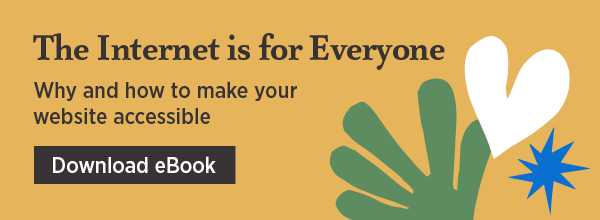This is part 3 of The Internet is for Everyone blog series. Read our previous blogs on website accessibility here.

In 1997, a group of designers and architects came together to develop the seven principles of universal design. Led by the late Ronald Mace, their intention was to create a guideline for designing environments, products and communications.
But what led Mace to become the Father of Universal Design?
For most of his life, Mace worked as an architect and was an advocate for universal design thinking. As a wheelchair user for most of his life, he had many barriers and understood what it’s like to live in a world that is not designed to be inclusive. Mace then became a passionate voice for accessibility and universal design. Before his death, he had created many opportunities for accessible design which still impact our work today.
Principles of universal design
User experience starts with users. People are the first consideration in any design, and that includes people with disability and impairments. Digital creators who use the seven guiding universal design principles will be better informed in creating inclusive and accommodating web design.
1. Equitable use
1a. Provide the same means of use for all users: identical whenever possible, equivalent when not
1b. Avoid segregating or stigmatising any users
1c. Provisions for privacy, security, and safety should be equally available to all users
1d. Make the design appealing to all users
Web design examples:
- High colour contrast helps users with colour blindness to differentiate content on a screen
- Provide alt text descriptions in images for screen reader users

2. Flexibility in use
2a. Provide choice in methods of use
2b. Accommodate right- or left-handed access and use
2c. Facilitate the user’s accuracy and precision
2d. Provide adaptability to the user’s pace
Web design example:
- A person who is sensitive to light will find it difficult to use a glaring screen without resulting in headaches or sleeping disorders. To address the issue, you can give them the option to turn off the blue light or to install applications
3. Simple, intuitive use
3a. Eliminate unnecessary complexity
3b. Be consistent with user expectations and intuition
3c. Accommodate a wide range of literacy and language skills
3d. Arrange information consistent with its importance
3e. Provide effective prompting and feedback during and after task completion
Web design examples:
- Ensure your content uses the appropriate headings (h1, h2 and h3) and are easy to follow visually
- Write in plain English and avoid using jargon so users can understand the content easily

4. Perceptible information
4a. Use different modes (pictorial, verbal, tactile) for redundant presentation of essential information
4b. Provide adequate contrast between essential information and its surroundings
4c. Maximise “legibility” of essential information
4d. Differentiate elements in ways that can be described (i.e., make it easy to give instructions or directions)
4e. Provide compatibility with a variety of techniques or devices used by people with sensory limitations
Web design example:
- Enable open/closed captions and Auslan interpretation in videos for users with audiovisual impairments

5. Tolerance for error
5a. Arrange elements to minimize hazards and errors: most used elements, most accessible; hazardous elements eliminated, isolated, or shielded
5b. Provide warnings of hazards and errors
5c. Provide fail safe features
5d. Discourage unconscious action in tasks that require vigilance
Web design examples:
- Ensure form error messages are located at the error location. This makes finding and fixing errors much more accessible for all users, especially the cognitively impaired
- Error messages should clearly explain the error and provide clear instructions on fixing the issue

6. Low physical effort
6a. Allow user to maintain a neutral body position.
6b. Use reasonable operating forces.
6c. Minimise repetitive actions.
6d. Minimise sustained physical effort.
Web design example:
- Enable keyboard shortcuts for users with limited mobility.
7. Size and space for approach and use
7a. Provide a clear line of sight to important elements for any seated or standing user.
7b. Make reach to all components comfortable for any seated or standing user.
7c. Accommodate variations in hand and grip size.
7d. Provide adequate space for the use of assistive devices or personal assistance.
Web design example:
- Allow accessible features such as the pinch-to-zoom function to work on mobile
Universal design is meant to be forgiving. As users, we enjoy products that are accessible to all. Download our eBook to learn how you could make accessible-friendly websites.
Topics: Accessibility, Brand
